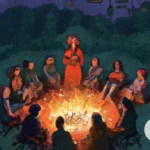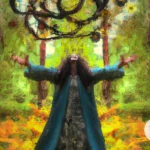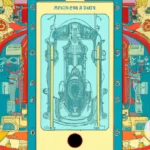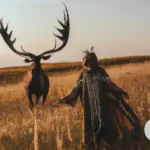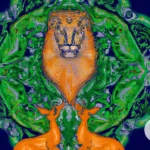Shamanic folktales have an integral role in the shamanic tradition, serving as a means of passing down the beliefs, practices, and values of the culture from generation to generation. At the heart of these tales lies the power of symbolism, which allows them to convey deeply complex ideas and emotions through simple and relatable imagery. The symbols used in shamanic folktales draw heavily from the natural world and the animal kingdom, as well as archetypes and personal experiences. Understanding the symbolism in these tales can offer insights into the shamanic worldview and also aid in personal healing, transformation, and empowerment. In this article, we will explore the power of symbolism in shamanic folktales and its importance within the shamanic tradition.
What is Shamanism?

Shamanism is a spiritual practice that has been around for thousands of years and is still practiced in various forms today. It involves a shaman, or spiritual leader, who serves as a mediator between the physical and spiritual world. Shamanic beliefs center around the interconnectedness of all things, including plants, animals, and humans. Shamanic practices often involve the use of drumming, chanting, and dancing to enter a trance-like state and communicate with the spirit world. The use of symbolism is also integral in shamanic practices and beliefs. Symbolism can be found in nature, animals, and archetypal symbols, which help to convey important messages and teachings in shamanic folktales. Shamans often retell these folktales to their communities as a way to teach spiritual wisdom and connect with their cultural heritage.
Shamanic Beliefs
Shamanism is an ancient spiritual practice that has been found in various cultures all over the world. It is based on the belief that there is no separation between the physical and spiritual worlds, and that everything in the universe is interconnected. Shamans are believed to be able to communicate with spirits and access alternative realities in order to bring about healing, guidance, and transformation.
Some common shamanic beliefs include:
| Belief | Description |
| Animism | The belief that everything in the natural world, such as trees, rocks, and animals, has a spirit or soul. |
| Ancestor worship | The belief that ancestors’ spirits continue to exist and can provide guidance and protection. |
| Power animals | The belief that everyone has an animal spirit guide that provides protection, guidance, and wisdom. |
| The Three Worlds | The belief that the universe is composed of three worlds: the upper world, middle world, and lower world, each inhabited by different types of spirits. |
| Cosmic Balance | The belief that everything in the universe is in a constant state of balance, and that imbalance can lead to illness and other problems. |
Shamanic beliefs vary based on the specific cultural context in which the practice is found. Nevertheless, there are many shared themes and beliefs across shamanic traditions that are reflected in shamanic folktales. To learn more about how shamanic beliefs are conveyed through folktales, check out our article on shamanic folktales in traditional cultures, and learn about how to retell shamanic folktales in contemporary times.
Shamanic Practices
Shamanic practices are a set of rituals and techniques that shamans use to enter a trance state, communicate with spirits, and connect with the spiritual realm. These practices are usually passed down through generations and are an essential part of many Indigenous cultures around the world.
Shamans use various methods to enter a trance state, including drumming, chanting, and dancing. This trance state is often referred to as a shamanic journey where the shaman undergoes spiritual experiences and visions that guide them in their healing work. In some cultures, shamans also ingest plant medicines that help them enter a deeper trance state.
Shamans believe that spirits are present in all aspects of life, including animals, plants, and natural elements. They communicate with and seek guidance from these spirits to help them in their healing work. Shamans also perform rituals that aim to balance the energies of the earth and the cosmos.
One essential shamanic practice is the creation of a sacred space. This is a place where the shaman feels safe and can perform their rituals and practices. The sacred space is often decorated with symbolic objects such as feathers, stones, and bones, which have specific meanings in shamanic culture.
In addition to healing, shamanic practices are often used for divination and insight into the past and future. The shaman may use various tools such as crystals, pendulums, or tarot cards to help them interpret their visions and messages from the spirits.
Shamanic practices are a vital part of many Indigenous cultures and serve as a way to connect with the spiritual realm and gain insights into the human experience. These practices have been passed down through generations and remain relevant today. To learn more about how shamanic practices are intertwined with folktales, read my article on Shamanic Folktales in Traditional Cultures and discover how retelling these tales can help keep shamanic culture alive in contemporary times.
The Role of Folktales in Shamanism
Folktales play a central role in shamanism as they are used to convey important spiritual teachings through imaginative, and symbolic stories. These tales are handed down from generation to generation, helping to preserve the shamanic beliefs and practices of indigenous communities.
Oral Tradition: Shamanic folktales are part of an oral tradition where knowledge is passed down through storytelling. The stories can be told in different ways, but their core messages remain the same. This method of passing knowledge has been used for centuries and is still used today.
Teaching Tools: Shamanic folktales serve as teaching tools, providing guidance and direction on how to live a meaningful life. They are often used to teach children important moral lessons and to educate them about the natural world. Through these tales, children learn about the relationships between humans, animals, plants, and the environment.
Cultural Preservation: Shamanic folktales help to preserve the cultural heritage of indigenous communities. These stories provide a connection to the past and help to maintain the continuity of tradition. They also serve as a way to communicate cultural values and beliefs to future generations.
Inspiration: Shamanic folktales inspire creativity and imagination in individuals. They provide a source of inspiration for artists, writers, and musicians who use the stories in their work. These tales also inspire individuals to connect with nature and the spiritual world.
Shamanic folktales are a crucial part of shamanism, serving as a means of passing knowledge, cultural preservation, teaching tools, and inspiration. They continue to hold significance and relevance, not only in indigenous communities but also in contemporary times. To learn more about retelling shamanic folktales, click here. For more information on shamanism, mythology, and folktales, click here.
The Importance of Symbolism in Shamanic Folktales
Symbolism is crucial to shamanic folktales as it communicates hidden meanings and wisdom that are not easily discernible through literal interpretation. Nature symbolism imbues natural elements with spiritual significance, such as the sun representing enlightenment and growth. Animal symbolism is a central feature of shamanism, where spirit animals are believed to convey guidance and protection to practitioners. Archetypal symbols, such as the hero’s journey or the sacred marriage, are universal motifs that speak to deeper human experiences and aspirations. Personal symbols, on the other hand, represent individual experiences and insights that are unique to each practitioner. Symbolism not only enriches the narrative of shamanic folktales, but also serves as a powerful tool for spiritual exploration and transformation.
Symbolism in Nature
Symbolism in nature plays a crucial role in shamanic folktales as it connects humans to the natural world. Natural elements often represent the power and beauty of the natural world, and they also hold profound spiritual meanings.
For instance, the sun can be seen as a symbol of vitality, growth, and enlightenment, while the moon can represent the feminine, intuitive, and emotional aspects of life. Trees and plants are also rich symbols in shamanic folktales with roots representing the connection to the earth and the underworld, while branches represent the connection to the heavens and the spiritual world.
Animals are another key element in symbolic natural imagery. The bear, for example, is often depicted as a symbol of strength, protection, and transformation. The eagle, on the other hand, represents freedom, insight, and spiritual illumination. In shamanic folklore, animals often serve as spirit guides that help individuals navigate their spiritual journeys and connect with the spirit world.
Water is also a powerful symbol in shamanic folktales. It represents the source of life and symbolizes deep emotions, the unconscious, and cleansing. The ocean or a river might symbolize life’s journey, with the current as a metaphor for the flow of life’s experiences.
Nature itself can also be seen as a crucible of transformation and healing. For example, a storm may represent chaos but also renewal and growth. A volcano may symbolize the eruption of inner turmoil, while the volcano’s eruption may represent the subsequent purification and cleansing of those emotions.
The symbolic meanings of nature in shamanic folktales remind us that we are all intimately connected to the natural world, with all its power and beauty. It encourages us to appreciate the natural world’s profound beauty and to develop a deeper understanding of our spiritual connection to the planet.
Animal Symbolism
Animal symbolism is a crucial component of shamanic folktales. Animals possess unique and powerful qualities that are often linked to specific meanings and attributes. These animal symbols are used to communicate important messages in shamanic tales. Here are some examples of animal symbolism in shamanic folklore:
| Animal Symbol | Meaning |
|---|---|
| Bear | The bear is associated with strength, power, and healing abilities. It is often regarded as a spiritual guide for shamans. |
| Wolf | The wolf is a symbol of loyalty, intelligence, and freedom. It is often viewed as a powerful guide for those embarking on a spiritual journey. |
| Snake | The snake symbolizes transformation, rebirth, and healing. It is also linked to wisdom and hidden knowledge. |
| Owl | The owl is a symbol of intuition, wisdom, and the ability to see beyond illusions. It is considered a messenger between the physical and spiritual worlds. |
| Deer | The deer symbolizes gentleness, grace, and sensitivity. It is often associated with the feminine energy and the power of intuition. |
In shamanic tales, animal symbols are used to illustrate important themes, such as the balance of masculine and feminine energies, the power of intuition and inner knowing, and the ability to connect with the natural world. The animals themselves are often viewed as spiritual allies, guides, and protectors for the shaman and other characters in the story.
Animal symbolism plays a critical role in shamanic folktales, helping to communicate important messages about the natural world, spirituality, and the human condition. By exploring the meanings and attributes of different animal symbols, we can gain a deeper understanding of the rich symbolism and wisdom inherent in shamanic tales.
Archetypal Symbols
Archetypal symbols are a significant aspect of shamanic folktales. These symbols represent universal patterns of human experience that are shared across cultures and time periods. These symbols are powerful and can evoke deep emotions and feelings within the reader.
Some of the most common archetypal symbols found in shamanic folktales include:
| Symbol | Meaning |
|---|---|
| The Circle | Represents unity, wholeness, eternity, and cyclical nature. It can be seen in the cycles of life and death, the changing of seasons, and the cycles of the moon. |
| The Tree | Represents growth, grounding, stability, and connection to the earth. The roots are below the surface and represent the unseen or subconscious, while the branches reach up into the sky, representing potential and growth. |
| The Hero | Represents the journey of self-discovery and transformation. The hero symbolizes the individual’s inner strength and courage to face their fears, overcome challenges, and reach their goals. |
| The Trickster | Represents the mischievous and unpredictable side of human nature. The trickster is often portrayed as a shape-shifter, who tests social norms and challenges authority. The trickster symbolizes the importance of humor and playfulness in life. |
| The Shadow | Represents the hidden and darker aspects of human nature, including fears, insecurities, and repressed emotions. The shadow symbolizes the importance of acknowledging and integrating all parts of ourselves, even the ones we don’t like. |
Archetypal symbols can provide a deeper understanding and connection to our own psyche and the world around us. They can be used as a tool for personal growth and transformation, as well as a way of teaching and passing on cultural beliefs and values. By understanding these universal symbols, we can gain a greater appreciation for the power of symbolism in shamanic folktales.
Personal Symbols
Personal symbols are unique to each individual and are often discovered through the shamanic journey. These symbols represent a person’s inner experiences, beliefs, and values. They are usually ingrained in the subconscious mind and can reveal themselves in dreams or visions.
Examples of personal symbols can include colors, shapes, animals, or objects that hold special meaning to the individual. These symbols can represent a person’s strengths, vulnerabilities, or personal goals.
To understand the meaning of personal symbols, a shaman will work with the individual to delve deep into their subconscious through meditation or journeying. The shaman will then interpret the symbols and provide guidance on how to incorporate them into the individual’s life.
Personal symbols can be used in shamanic healing to address emotional or physical imbalances. This is done by visualizing the symbol and using its energy to promote healing. For instance, a person may have a personal symbol of a bird, which could represent freedom and a desire to transcend limitations. By focusing on this symbol during meditation, the person can access its energy to overcome fear or a sense of being trapped.
In some cases, personal symbols can also serve as protection. For example, a person may have a personal symbol of a shield, which represents safety and self-defense. By visualizing the shield during times of vulnerability, the person can feel empowered and protected.
Working with personal symbols requires trust in the shaman and a willingness to engage in deep introspection. It can be a powerful tool for self-discovery and growth, allowing individuals to unlock hidden aspects of themselves and overcome obstacles.
Personal symbols serve as a unique and personalized tool for understanding oneself and promoting healing and growth. They are a powerful aspect of shamanic practice and can have a profound impact on an individual’s life.
Symbolic Elements in Shamanic Journeys
During shamanic journeys, the symbolism is often present in the form of visionary images, sensations and emotions. These elements can take the form of animals, landscapes, colors, sounds, and symbols that carry personal or archetypal meanings.
Shamans interpret these symbolic elements and use them as tools for healing and self-discovery. The symbols can represent the unconscious mind and can reveal important information, assisting an individual in identifying and addressing emotional blockages, limiting beliefs, and past traumas.
As a shamanic journey unfolds, the individual may encounter guardian spirits or animal guides that offer guidance and protection. These animal allies, which can take the form of a wolf, a bear, or even a mythical animal such as a dragon, may be interpreted to represent specific qualities needed by the individual, such as strength or courage.
Other symbolic elements that may be encountered on a shamanic journey include portals that represent doorways to other dimensions, bridges that symbolize connections between worlds or parts of the self, and caves that signify the dark and unknown parts of the psyche.
Through interpretation of these symbolic elements, a shamanic practitioner is able to help an individual gain deeper understanding of themselves, their life path and their capabilities. They can also identify what is holding them back and offer guidance to overcome it. The transformative power of symbolic elements in shamanic journeys can lead to profound personal healing and transformation.
How Symbolism Helps in Shamanic Healing and Transformation
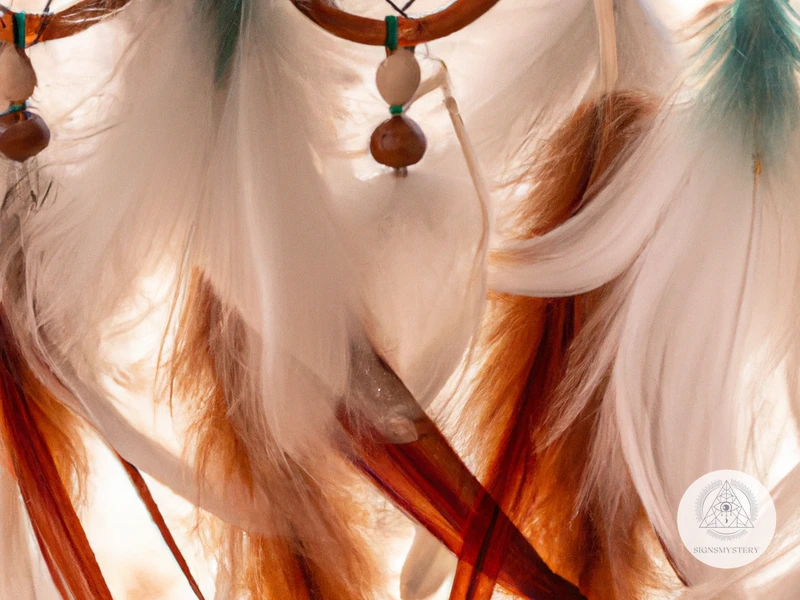
Symbolism plays a crucial role in shamanic healing and transformation as it helps individuals to connect with their unconscious mind in a profound and meaningful way. Through symbols, the shaman can interpret and decipher the messages from the unconscious mind, which can lead to a deeper understanding of oneself and the world around them. By exploring the symbolic language of dreams, visions, and other forms of symbolic communication, individuals can gain insight into their emotional, physical, and spiritual needs. Through symbolic death and rebirth, individuals can shed old patterns and beliefs that no longer serve them and embrace new ways of being. The use of personal symbols can also help individuals tap into their unique talents and skills, leading to greater self-awareness and empowerment. Symbolism serves as a powerful tool for uncovering the hidden aspects of the self and facilitating transformation and healing.
Symbolic Language and the Unconscious Mind
The power of symbolism in shamanic folktales lies in their ability to communicate with the unconscious mind through symbolic language. In the context of shamanism, the unconscious mind is considered to be the source of all spiritual knowledge and healing. It is the part of us that holds our deepest desires, fears, and beliefs – often beyond our conscious awareness.
Through the use of symbolism, shamanic stories can bypass the analytical mind and reach directly into the unconscious, where profound transformation can occur. Symbols act as a bridge between the conscious and unconscious, allowing us to access inner wisdom and connect with the spiritual world.
One example of symbolic language in shamanic folktales is the use of animals as power symbols. Animals are archetypal symbols that tap into universal themes and energies. Each animal carries its own unique qualities and symbolism, such as the wisdom of the owl or the courage of the lion. By invoking these animal allies, we can tap into their wisdom and qualities and embody them in our own lives.
Another example of symbolic language is the use of elemental motifs, such as fire, water, earth, and air. These elements are universal symbols that represent the building blocks of life and the forces of nature. By connecting with these elements, we can tap into the deeper rhythms of the natural world and harness their transformative power.
Ultimately, the use of symbolic language in shamanic folktales allows us to communicate with the unconscious mind in a way that is both profound and transformative. Through the power of symbols, we can unlock the wisdom of the spiritual world and access deeper levels of healing and transformation.
| Examples of Symbolic Language in Shamanic Folktales | Symbolic Meanings |
|---|---|
| The wolf | Power, wisdom, instinct |
| The serpent | Transformation, healing, rebirth |
| The tree | Grounding, connection to the earth, growth |
| The eagle | Vision, clarity, spiritual freedom |
Healing Trauma through Symbolic Representations
Shamans often use symbolic representations to help individuals heal from trauma. Trauma can manifest emotionally, physically, mentally, and spiritually, and can be caused by various events, such as abuse, loss, accidents, and much more. Symbolism can be a powerful tool to create a safe and supportive environment for individuals to process their trauma and achieve inner healing.
The use of symbolic representations in shamanic practices allows individuals to explore their trauma in a non-threatening manner. Symbols can be used to represent difficult feelings that are hard to verbalize. They provide a way for individuals to express themselves and explore their emotions without creating further trauma or stress. Symbols can also be used to help individuals gain a deeper understanding of their trauma and develop new perspectives.
Shamans often use symbolic representations in journeying and other healing rituals. They may use animal spirits to represent different emotions or aspects of a person’s personality. For example, if someone is struggling with feelings of fear, a shaman may use a wolf spirit to help them confront and overcome these emotions. Alternatively, if someone is struggling with feelings of vulnerability, a shaman may use a dove spirit to help them gain a sense of peace and safety.
Through the use of symbolic representations, a shaman can help an individual process their trauma and begin to heal. Symbols can also help individuals develop new coping mechanisms and become more resilient. With continued use, the symbolic representations can become a symbolic anchor, helping individuals feel grounded and connected to their inner wisdom and power.
The use of symbolic representations in shamanic practices can be an effective way to help individuals heal from trauma in a safe and supportive environment. Symbols provide a non-threatening way for individuals to express their emotions and gain a deeper understanding of their trauma. As individuals continue to use symbols in their healing journey, they can develop resiliency and become more connected to their inner wisdom and power.
Transformation through Symbolic Death and Rebirth
One of the most powerful ways that symbolism is used in shamanic folktales is to represent the transformative process of death and rebirth. This is a symbolic representation of the experience of death and rebirth that we all go through in our lives, whether it be physical or spiritual. The shamanic journey is often seen as a death and rebirth experience, where the shaman must face their own mortality in order to be reborn into a new understanding of themselves and the world.
Symbolic Death and Rebirth in shamanic tales often occurs in the form of a journey to the underworld. This is a place where the shaman must confront their deepest fears and confront the reality of their mortality. This journey is often accompanied by tests and trials, where the shaman must prove their worthiness to be reborn into a new level of understanding.
The journey to the underworld is a powerful metaphor for the transformative process of death and rebirth. The shaman must let go of their old identity and embrace a new one in order to move forward on their journey. This is often represented as a process of shedding old skin, or the death of the old self, in order to be reborn into a new understanding of the world.
Through this process of symbolic death and rebirth, the shaman is able to gain new insights and perspectives on the world around them. They are able to let go of old patterns and beliefs that no longer serve them, and embrace new ones that allow them to grow and evolve as individuals.
The Benefits of Symbolic Death and Rebirth in shamanic healing and transformation can be profound. The experience of facing one’s own mortality and shedding old patterns can lead to a sense of empowerment and liberation. The shaman is able to let go of old traumas and wounds, and embrace a new sense of purpose and meaning in their life.
Symbolic death and rebirth can also help individuals to heal from past traumas and wounds. By facing their fears and confronting the reality of their own mortality, they are able to shed old scars and emerge as new, healed individuals.
Symbolism plays a crucial role in shamanic folktales by enabling individuals to connect with deeper aspects of themselves and the world around them. Through symbolic death and rebirth, individuals are able to transform their lives and emerge as new, empowered individuals.
Empowerment through Symbolic Animal Allies
Empowerment through Symbolic Animal Allies is a central aspect of shamanic practice. In shamanism, animals are considered sentient beings with their own unique traits and powers. They are seen as spirit helpers, or allies, that can assist individuals in their personal transformation and growth. Below are some examples of symbolic animal allies and the empowerment they can offer:
| Animal | Empowerment |
|---|---|
| Bear | Bear represents strength, courage, and grounding. It can help individuals connect with their inner power and overcome obstacles. |
| Wolf | Wolf represents loyalty, protectiveness, and intuition. It can offer guidance and protection on one’s journey. |
| Hawk | Hawk represents vision, clarity, and higher perspective. It can help individuals see beyond the surface and gain insight into their situation. |
| Snake | Snake represents transformation, renewal, and rebirth. It can assist individuals in shedding what no longer serves them and embracing a new chapter. |
Working with animal allies involves developing a relationship with the animal spirit through meditation, journeying, or dreams. The animal may appear in various forms, such as in visions or in physical reality. Once a connection is established, the individual can call upon the animal ally for guidance, protection, and support.
Empowerment through symbolic animal allies goes beyond just personal growth. It also involves honoring and respecting the interconnectedness of all life on earth. Animals are seen
Subscribe to Our Newsletter
Sign up to receive the latest news and updates.
In shamanic practice, animals are not worshipped or manipulated for personal gain. Rather, they are viewed as equals and partners in the journey towards healing and wholeness. By embracing the empowerment offered by symbolic animal allies, individuals can tap into their personal power and create positive change in their lives and the world around them.
Integrating Personal Symbols into Everyday Life
Personal symbols are symbols that are unique to an individual and hold personal meaning. Integrating personal symbols into everyday life can be a powerful way to connect with the unconscious mind and access deeper levels of insight and wisdom.
One way to integrate personal symbols is to display them in our physical environment. This could be in the form of artwork, jewelry, or even home decor. By surrounding ourselves with our personal symbols, we are reminded of the deeper meaning and significance they hold for us.
Another way to integrate personal symbols is to incorporate them into daily rituals and practices. For example, a person who identifies strongly with the symbol of the wolf may choose to incorporate wolf imagery into their meditation routine or daily affirmations. This can help to strengthen the connection between the individual and their personal symbol, creating a deeper sense of meaning and purpose in their life.
Journaling can also be a useful tool for integrating personal symbols. By reflecting on our experiences and emotions through the lens of our personal symbols, we can gain deeper understanding and insight into our inner world. This can be particularly helpful when working through difficult emotions or experiences, as personal symbols can serve as a source of comfort and guidance.
Integrating personal symbols into everyday life can be a powerful tool for personal growth and transformation. By connecting with our personal symbols, we connect with our deepest selves and the unconscious wisdom that lies within us.
Examples of Symbolism in Shamanic Folktales
The symbolism found in Shamanic Folktales is rich and varied. One example is the story of the White Buffalo Calf Woman, who is a symbol of purity, peace, and spirituality. She brought the sacred pipe to the Lakota people, and her appearance signaled the beginning of a new era of understanding and cooperation between tribes. Another example is the Trickster Coyote, who represents both the light and dark sides of human nature. Coyote is known for his cunning and mischief, but also his ability to teach valuable lessons through his antics. The Sacred Hoop is also a powerful symbol, representing the interconnectedness of all things and the importance of maintaining balance and harmony. Finally, the Journey to the Underworld is a common theme in Shamanic Folktales, symbolizing the importance of facing our fears and shadow selves in order to achieve transformation and growth.
The White Buffalo Calf Woman
The story of the White Buffalo Calf Woman is a powerful and sacred narrative found in many Native American cultures, including the Sioux, Lakota, and Cheyenne tribes. According to legend, two warriors were out hunting when they saw a beautiful woman in the distance. As they approached her, they noticed that her clothing was made of white buffalo hides, and that a single white calf was grazing nearby. The woman told the warriors that she had a message for their people, and she asked them to gather the elders and prepare a feast.
When the elders had come together, the woman showed them a special pipe decorated with eagle feathers, and she taught them how to use it in sacred ceremonies. She also shared with them the gift of the buffalo, instructing them to honor and respect these sacred animals as sources of food, clothing, and other necessities. Before she left, the woman promised to return and provide guidance to the people in times of need, and she transformed into a white buffalo before their eyes.
The story of the White Buffalo Calf Woman is full of symbolism, and it holds deep meaning for those who practice shamanism. The woman herself symbolizes purity and healing, and her white buffalo clothing represents the sacredness of all living beings. The eagle feathers on the pipe represent the power of the sky, and the pipe itself symbolizes the connection between the physical and spiritual worlds.
The gift of the buffalo is a symbol of abundance, strength, and resilience, and it acknowledges the interdependence of all living things. The buffalo, in many Native American cultures, is viewed as a symbol of power, wisdom, and leadership. The calf in the story represents innocence and new beginnings, and its presence reinforces the theme of renewal and rebirth.
In shamanic practices, the story of the White Buffalo Calf Woman can be used as a source of inspiration and guidance. The pipe ceremony taught by the woman can be recreated as a way to connect with the spirit world and seek wisdom from the ancestors. The symbolism of the buffalo can be utilized in healing and transformational rituals, and the story itself can be recounted as a reminder of the sacredness of all life.
The continuing relevance of the White Buffalo Calf Woman story is evidenced by its presence in contemporary Native American culture and in the broader spiritual community. Its themes of unity, respect, and reverence for the natural world provide a valuable message for all those seeking harmony and balance in their lives.
The Trickster Coyote
‘The Trickster Coyote’ is a prominent figure in many shamanic folktales. Coyote is often depicted as a clever, mischievous, and cunning character who sometimes plays tricks on other animals or humans. However, Coyote can also be seen as a symbol of resilience, adaptability, and survival in difficult situations.
Coyote’s trickster nature is often used in shamanic tales to teach important lessons about life and spirituality. For example, in some stories, Coyote is punished for his misdeeds, showing the importance of following moral standards and respecting others’ boundaries. In other tales, Coyote’s cunning and adaptability are celebrated, showing how these traits can help one overcome obstacles and challenges in life.
Coyote is also often used as a symbol of transformation and change. In some stories, Coyote transforms into different animals or even objects, reflecting the cyclical nature of life and the constant need for adaptation and transformation. In other tales, Coyote is shown undergoing a process of death and rebirth, highlighting the importance of embracing change and letting go of the past.
Coyote can be seen as a representation of the human ego and its relationship with the natural world. In some shamanic stories, Coyote is portrayed as an egotistical character who learns to connect with nature and embrace his role as a small part of the interconnected web of life.
The Trickster Coyote is a rich and complex symbol in shamanic folklore, representing a range of themes, including resilience, adaptability, transformation, and our relationship with the natural world. Through Coyote’s antics and shenanigans, shamanic tales teach us valuable lessons about life and spirituality, helping us navigate the complexities of our existence with wisdom, humor, and grace.
The Sacred Hoop
The Sacred Hoop is a powerful symbol in many Native American shamanic folktales. It represents the interconnectedness and interdependence of all living things in the universe. The hoop represents the cyclical movement of life, death, and rebirth and the balance between the physical, emotional, mental, and spiritual aspects of existence.
In many stories, the Sacred Hoop is said to have been passed down to humans from the Creator or Great Spirit as a way of reminding humanity of their connection to all life forms. It is sometimes also referred to as the Medicine Wheel.
The Sacred Hoop is usually depicted as a circle divided into four quadrants, each representing a direction and an element. These elements are usually fire (south), water (west), air (north), and earth (east). Each direction and its corresponding element are believed to hold different energies, powers, and qualities that humans can tap into for healing and empowerment.
Here is a breakdown of the four directions and their meanings:
| Direction | Element | Meaning |
|---|---|---|
| South | Fire | Passion, energy, creativity, and the warmth of the sun. |
| West | Water | Emotions, flow, intuition, and the cleansing power of water. |
| North | Air | Wisdom, clarity, vision, and the fresh coolness of the air. |
| East | Earth | Grounding, stability, growth, and the nurturing power of the earth. |
In shamanic journeys and healing sessions, individuals may use the Sacred Hoop as a tool for finding balance and gaining insight into their lives. They may meditate on the different directions and elements and ask for guidance from their spirit guides or ancestors. By recognizing their interconnectedness to all things and tapping into the energies of the different directions and elements, individuals can gain a deeper understanding of themselves and their place in the world.
The Sacred Hoop reminds us that we are all connected and that our actions have consequences that ripple through the universe. It teaches us to respect and honor all living things and to live in harmony with nature. In a world that often values individualism and competition, the Sacred Hoop represents a powerful reminder of our interconnectedness and the importance of living in balance and harmony.
The Journey to the Underworld
In shamanic folklore, the journey to the underworld is a powerful symbol of transformation and self-discovery. This journey is often undertaken by the shaman for the purpose of retrieving lost souls or gaining knowledge from the spirit world. The underworld itself is seen as a realm of darkness and mystery, inhabited by the spirits of the dead and other supernatural beings.
During the journey to the underworld, the shaman passes through various symbolic landscapes and encounters many obstacles and tests of strength and courage. These experiences are not only external but also internal, representing the shaman’s own inner demons and challenges to their own identity and sense of purpose.
One key aspect of the journey to the underworld is the shaman’s encounter with their own shadow self, representing the darker aspects of their subconscious mind. This aspect of the journey is often seen as the most difficult and dangerous, as the shaman must confront their own fears and come to terms with their own flaws and weaknesses.
Another important element of the journey to the underworld is the encounter with spirit guides and animal allies. These guides provide the shaman with protection, guidance, and knowledge, helping them navigate the treacherous terrain of the underworld and fulfilling their quest.
The journey to the underworld is also symbolic of the shaman’s own death and rebirth, as they face the ultimate test of letting go of their old self and embracing a new identity. This process of transformation is often seen as essential to healing and personal growth, as the shaman emerges from the underworld with a deeper understanding of themselves and their place in the world.
The journey to the underworld is a rich and complex symbol in shamanic folklore, representing the challenges and rewards of transformation and self-discovery. It remains an important source of inspiration and guidance for those seeking to explore the depths of the human psyche and the mysteries of the spirit world.
Conclusion
In conclusion, the power of symbolism in shamanic folktales cannot be underestimated. The use of symbols in these tales serves as a means of communication with the unconscious mind and aids in healing and transformation. Symbols derived from nature, animals, and archetypes are powerful tools for shamanic practitioners to work with. The personal symbols that arise during shamanic journeys hold great significance for individuals and can be integrated into everyday life. Through the use of symbolism, shamanic folktales continue to be relevant in contemporary times and offer insights into the human experience that are both timeless and universal. Overall, the importance of symbolism in shamanic folktales lies in its ability to connect individuals to the deeper aspects of their being and to the world around them, providing them with a sense of clarity and understanding that is essential for their growth and development.
Summary of the Importance of Symbolism in Shamanic Folktales
Summary of the Importance of Symbolism in Shamanic Folktales:
Symbolism is a fundamental part of shamanic folktales and plays a crucial role in shamanism itself. The power of symbolism in shamanic folktales can be seen in the following ways:
1. Facilitating communication: Symbols provide a way for shamans to communicate with their allies, spirit guides, and the divine. It allows for a universal language that transcends traditional communication barriers.
2. Connecting with nature: Symbolism in shamanic folktales is often closely tied to the natural world. This connection with nature helps shamans to connect with their own inner nature and to find balance within themselves.
3. Uncovering deeper meanings: Symbols provide layers of meaning that can be unfolded over time. This allows shamans to explore the depths of their own psyche and to bring hidden aspects of themselves into the light.
4. Encouraging healing and transformation: Symbolism can help shamans to heal from past trauma, undergo transformations, and gain new perspectives on themselves and the world around them.
5. Providing guidance: Symbols can act as guides for shamans on their spiritual journeys, helping them to navigate the unknown and find their way to their destination.
The power of symbolism in shamanic folktales is immense – it allows for deeper connections with nature, facilitates communication with the divine, and provides a framework for healing and transformation. By understanding the importance of symbolism, shamans can harness its full potential in their work and continue to connect with the spiritual world in powerful and meaningful ways.
The Continuing Relevance of Shamanic Folktales in Contemporary Times
In today’s world, it can be easy to dismiss the relevance of ancient shamanic traditions and folktale symbols. However, the truth is that these traditions continue to hold immense value in contemporary times. One of the primary reasons for this is that, despite the layers of modernization, we as a species continue to experience the same fundamental emotions and have the same questions about life and the human experience that our ancestors did.
Shamanic folktales provide a deep connection to this shared human experience. They allow us to explore complex themes and universal ideas that transcend the limits of time and place. By tapping into the symbolism and imagery presented in these stories, we can gain insight into our own lives and the world around us.
Additionally, as we continue to search for meaning and purpose in an increasingly uncertain and chaotic world, shamanic folktales offer a sense of connection and grounding. They remind us of the interconnectedness of all things and the importance of maintaining our spiritual and emotional health. This is especially true as we face unprecedented levels of stress and anxiety in the modern world.
Finally, shamanic folktales are a reminder of the resilience of the human spirit. Throughout history, cultures around the world have faced countless challenges and hardships, yet they have continued to tell stories that reflect their innermost fears, hopes, and aspirations. These ancient tales provide a powerful reminder that, even in the darkest of times, there is always the potential for growth, transformation, and healing.
In these ways, shamanic folktales continue to be relevant and necessary in contemporary times. They provide a window into our shared human experience, a sense of grounding and connection, and a reminder of our own inherent resilience. As we continue to navigate the complexities of the modern world, we would do well to remember the wisdom and insight that these timeless tales have to offer.
Frequently Asked Questions
What is the origin of shamanic folktales?
Shamanic folktales have their roots in the oral traditions of indigenous cultures around the world. They were passed down from generation to generation as a way of preserving cultural beliefs, practices, and knowledge.
What is the purpose of shamanic folktales?
The purpose of shamanic folktales is to teach and inspire people. They convey important messages about the natural world, human nature, and the spiritual realm. They are also used by shamans as a way of accessing the spirit world and gaining insight into healing and personal growth.
What is symbolism in shamanic folktales?
Symbolism in shamanic folktales refers to the use of objects, animals, and other elements to represent ideas, emotions, and spiritual concepts. Symbolism is an important tool in shamanic healing and can also be used to convey powerful messages to those who listen to or read shamanic folktales.
Why is symbolism important in shamanic healing?
Symbolism is important in shamanic healing because it helps the shaman to access the unconscious mind and facilitate healing on a deep level. Symbols can be used to represent aspects of the self that are buried or hidden, and can help bring them to consciousness for healing and integration.
What is the role of animal symbolism in shamanic folktales?
Animal symbolism is an important part of shamanic folktales as animals are often viewed as spiritual guides or allies in shamanic practices. They represent different aspects of the human psyche and can be used to facilitate healing and personal growth.
How can personal symbols be integrated into everyday life?
Personal symbols can be integrated into everyday life by identifying objects or images that hold personal significance and incorporating them into daily routines, meditation practices, or artwork. This can help to deepen one’s connection to the unconscious mind and promote personal growth and healing.
What is the significance of the journey to the underworld in shamanic folktales?
The journey to the underworld in shamanic folktales is often a metaphor for personal transformation and growth. It is a journey into the realm of the unconscious mind where buried emotions, memories, and traumas can be confronted and healed.
How can symbolism be used to heal trauma?
Symbolism can be used to heal trauma by providing a safe container for the expression of difficult emotions and experiences. By using symbols to represent traumatic events or emotions, one can gain distance and perspective, allowing for greater healing and integration.
What is the significance of archetypal symbols in shamanic folktales?
Archetypal symbols in shamanic folktales represent universal human experiences and emotions. They are symbols that are commonly found across cultures and can be used to convey powerful messages or facilitate healing and personal growth.
How can shamanic folktales be relevant to contemporary times?
Shamanic folktales can be relevant to contemporary times by providing a lens through which to view modern issues and challenges. They offer a way of connecting with nature, the spiritual realm, and one’s own inner wisdom, which can be valuable tools for navigating the complex world we live in today.



